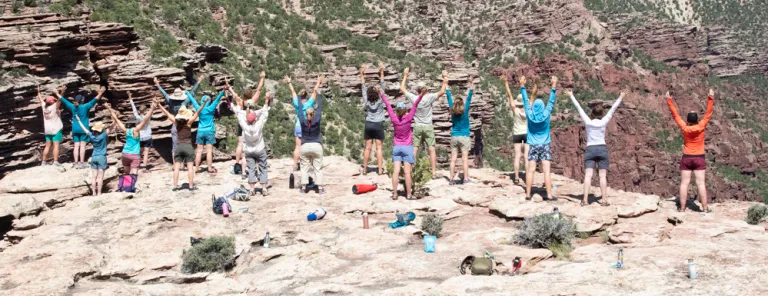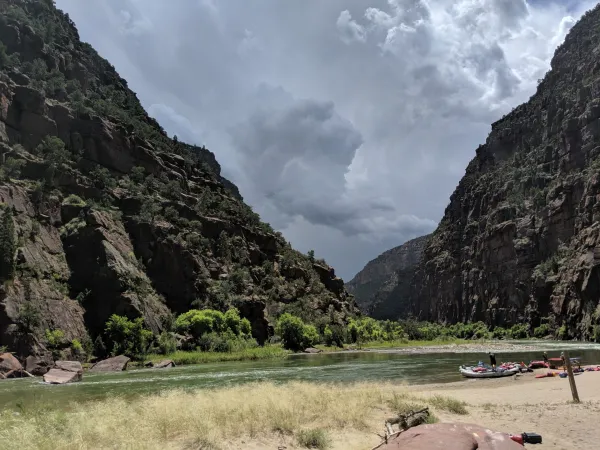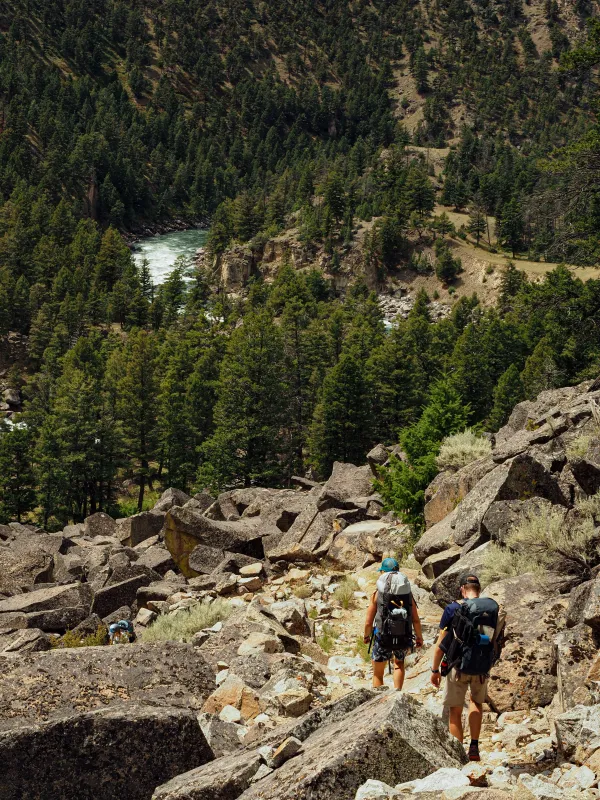The following post is an abridged version of a longer piece written by Marianne M. Porter, a participant on the Freeflow Institute’s “Stories in Sandstone” course in 2019. As part of the wilderness writing workshop, the participants rafted on the Green River through the sandstone canyons of the Gates of Lodore, part of Dinosaur National Monument. The trip was hosted and taught by renowned award-winning author Pam Houston.
Marianne Porter lives in the Sierra Nevada Mountains of Northern California. Since the mid-‘80s, whitewater rafting has been a favorite summer adventure, as well as camping, hiking, and mountain biking. In the winter, she enjoys cross-country skiing. Year-round she loves photographing wildlife in her yard, road trips, and traveling. In 2014, she earned her MFA in Creative Writing at Sierra Nevada College, and is working on a collection of linked short stories with the working title, When the Clock Strikes Five.
Rockslide
by Marianne M. Porter

Rockslide. noun. – a rapid downward movement of rock fragments that slide over an inclined surface along an area of weakness.
Sound asleep in my tent along the Green River in Utah, I woke to a loud crackling noise that shot me upright. I looked out the screen window of my tent across the river in a narrow stretch of Lodore Canyon, to witness a light show like nothing I had ever seen before in Mother Nature. White twinkles glistened and popped like the tail end of a fireworks display on a 4th of July night at Donner Lake, except this was July 7th, and I was in Dinosaur National Monument on a three-night writing and whitewater raft trip.
Mesmerized by the magic, wonder, and splendor of what I was witnessing, I stepped onto the sandy beach and stared as rocks crashed from a two-thousand-foot-tall red sandstone wall in Dinosaur National Monument. No one in our group of twenty-four had ever witnessed a nighttime rockslide. A cloud of dust rose across the river as a section of canyon wall tumbled. I wondered if there would be a new rapid across from camp. Darkness from the moon’s first-quarter phase felt unsettling. The rockslide’s sound — intense, confusing, even terrifying — shook me. When the dust settled everyone retreated to their sleeping bags and I tried to nod off. I powered on my iPhone and it read 3:27 a.m. My mind stirred, wide and raging.
Once I started writing, all obstacles disappeared, doubts flattened and a new course formed. I was as free-flowing as the river before me, as the flood of sparks I had witnessed the night before.
This trip called “Stories in the Sandstone” resonated with me the moment I read about it on writer Pam Houston’s website. It melded two loves of mine: writing and river life. My love of rivers awoke in 1988 when I canoed the Green River from Moab, Utah, to Cataract Canyon below the confluence of the Colorado River. We were four couples in four canoes with all our gear in tow. Since that trip I had never traveled on a river without my husband Jim, and close friends Jeanne and Dave. On later trips, my two daughters would join us as soon as they were old enough to follow directions and hold on tight. Now, I was ready to take this trip by myself.
“The rockslide was an unexpected moment of wonder,” Pam said in the first morning circle following the rockslide and after coffee and pancakes with berries. This was a literal example of what she calls glimmers, moments of resonance, things you feel in your gut, things you know are important and will remember. At the time, I didn’t know how significant the startling rockslide metaphor of breaking open, shifting, and letting go would become.

Rockslide. – Rocks may freefall or carom down in an erratic sequence of tumbling, rolling, sliding.
When my lifelong friend Mona and I first visited Colorado in 1979 we were escorted to the Colorado River somewhere along I-70 by her friend Dean who led us to the river’s edge and told us we had to take off our shoes and socks, and dip our feet in the cold water.
Whenever I’m on the river I feel an immediate transformation as I settle into the boat and sense the rhythm of the water. I drop one foot over the side of the raft and let it drag in the current as a ritual of welcome. Glassy reflections of sky and cloud formations on the water’s surface, imposing canyon walls, wide wingspans of ravens, osprey, and eagles, families of hooded mergansers, an occasional great blue heron. All things that mesmerize me and offer peace. For me, river canyons are a slice of heaven. I savor the seclusion. News reports and online chatter disappear, watches get stowed away and are replaced with the sound of oars dipping into and releasing droplets of water.
Form is essential to creating clear, understandable writing, Pam said one afternoon. “You don’t want to alienate your reader with your chaos.” I nodded in agreement.
She gave us an assignment to write a scene or story of 26 sentences each one beginning with a consecutive letter of the alphabet. One sentence had to be one word. One sentence had to be exactly 50 words. Yes, we had to count them.
The first word I wrote was L-A-R-D-O, in all caps, and from there reminders of my father’s verbal abuse hit the page.
Continuing on from the letter L, I formed my next sentence beginning with M.
My father called me that from time to time while I was growing up, a real wiseacre he was, throwing out hurtful words without concern for my startled brain unable to believe he really meant it, where did that come from? Was I really fat? I can’t shake that word.
Now, I understand he was bullied…
Over and over again by his older brother or his tough-handed father who left his home in Ireland two years before his family followed to begin a new life in America.
Once I started writing, all obstacles disappeared, doubts flattened and a new course formed. I was as free-flowing as the river before me, as the flood of sparks I had witnessed the night before.

Rockslide. – loss of support from underneath or detachment from a larger rock.
Perhaps if anyone had talked about our family history while I was growing up, I would have understood more about their past hardships. Back to the L word I can’t shake: when I was eight, my Girl Scout leader sewed each girl in my troop a costume to wear for International Day — a celebration in which each of us would represent a different country and perform a dance on stage at my school. I chose Ireland excited to make my father proud. My white dress with green shamrocks on the apron and white puff sleeves transformed me into an Irish step dancer. My father had a 35 mm Kodak camera with an attached brown leather case in which he documented much of my and my brothers’ childhood. I stood proud, erect, happy as I faced the camera for a shot before the performance. He looked through the viewfinder and saw something he didn’t like. He clicked the shutter and puffed a sound of exasperation. “Well, you don’t look like a real Irish step dancer.” He said step dancers are thinner than I was. Too stunned to cry, I stood and stared. I think there’s a slide somewhere in a Kodak carousel tray that shows an eight-year-old girl wearing a distant half-smile, eyes dull with shame. I remember beginning the dance on stage. I remember forgetting some of the steps I had rehearsed. I remember crying because I felt like I failed. I remember being frightened because for that moment I hated him.
Like those falling glimmers of light created by rock bouncing off rock, I broke open my sealed compartment. My writing that day would betray my father and cause me great pain. I had finally shattered a part of my past, and there it was on the page. Just like the river corridor that had changed in the shifting, sculpting, rearranging way it does, I too was changing. My hidden fears, pieces of me that I was uncomfortable accepting, painful words from the past that I wished would erode away, emerged.
Pam acknowledged my feelings and said the exercise on form had worked, even fooled me. In our previous evening’s circle, she explained how form allows the subconscious into the writing process, and that we can’t make art out of our analytical mind. We talked about LARDO, its powerful opening, how my words manifested outside of myself, how this straightforward form allowed it to happen.
Wishing we could have talked. Wishing family matters could be pressed to perfection with smooth, warm, honest words, not harsh explosions.
Yellow. I called my father yellow once to test my 15-year-old power. He slammed his fist on the kitchen table, turned red, warned me to never say that again. I don’t remember why I said that.
“Today,” Pam said, “might be a day when you need to cry a lot. That’s okay. This is your day to do whatever you need.” I wanted to give her a bear hug but hesitated. How many hugs from teary writers can one person take?
On the third day we climbed along a fairly steep trail to the top of a wide, flat bluff called Limestone, a sentinel two-hundred-eighty feet above the river which offered a stunning, commanding view up the Green River corridor. Part of the Lodore Formation, this brownish-white rock became our place of worship. Pam stood near the front of the ledge and raised her arms to breathe in the river. She called out to me: “Marianne. Come here. You need this today.” I did, and I did. In a few seconds, the entire group of writers and a few guides stood, faced the river canyon, and raised arms in praise. A guide captured the moment with a borrowed Canon. It’s one of my favorite photos.
Atop Limestone, I settled into a warm, comfortable patch of rock as Chandra read an excerpt from John McPhee’s Encounters with the Archdruid about environmentalist David Brower’s battle against the Commissioner of the US Bureau of Reclamation, Floyd Dominy. Brower would later succeed in halting construction of a dam in Dinosaur National Monument.
I leaned back onto my open hands stretched behind me and connected to the vast scene before me: Chandra facing us as she read about the real possibility of almost having lost this magnificent canyon to flooding by a dam.
Far below, the Green River forged its way right around the corner on its way to the confluence with the Yampa River. Ahead and to my left, higher limestone cliffs rose in layers close to two-thousand feet above where we sat. I felt cocooned in this magnificent rock cathedral. Ravens floated effortlessly on currents. Everyone stilled their bodies to absorb the meditative moment. I felt more wholeness and peacefulness with every breath I took, grateful for this memorable pause in our day.
The last night on the river I raised my lime green can of Moose Drool ale at the shaded canyon walls and dark sky with uncountable stars. I saw the river current swirl and bend, looked down at my toes in the sand, and thought of my father. I realize you never had an opportunity like this, I thought to myself, and I’m sorry for that. But I do, and I’m very grateful for every minute of it. I suppose in some way he helped make this happen by not stopping me from leaving. I don’t know if he ever would have been able to release his anger and set himself free. He had come from afar. He had worked hard and sometimes his expectations were shot in half. He didn’t understand why I left the East Coast so young, why I never planned to return. My soul belonged in the West. Maybe my baptism in the Colorado River years before had made all the difference, made me realize that I always had to take off my shoes and socks, and dip my feet into the water.
Lots of gratitude to Marianne, for her bravery and beautiful writing. Thanks also to our professional outfitting partner, Dinosaur River Expeditions of Vernal, Utah, who showed us the magic of Gates of Lodore; to Big Sky Brewing who fuels our writing with cold Montana beers; and to Pam Houston, who is an absolute master of her craft and generally spectacular human being.











